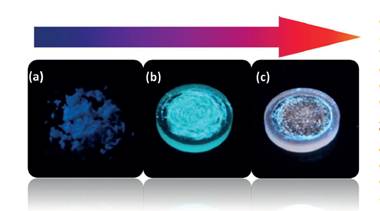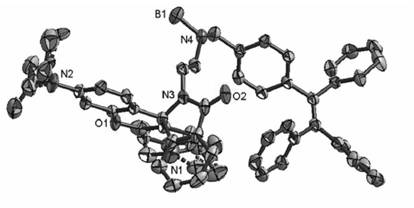Peking University, Dec. 15, 2015: Think about these: when you are climbing, the color of the climbing rope changes to tell you whether it is overstressed; when there are too many cars running on a bridge, the coating of the bridge shifts to a different color to set off the alarm; when a cyclist is hurt in a crash, the color of his helmet signals how hard he is hit, helping the medical personnel to access his injury.
All these awesome technologies depend on a kind of fluorescent material - materials that change color in response to force (mechanochromicluminesecent material, MCL). Scientists have successfully found and synthesized different MCLmaterials. And most of them could display a reversible two-color change. Now a new smart member is going to join the family. Professor Jia Xinru and Professor Ma Yuguo, from the College of Chemistry and Molecular Engineering, and their groups recently reported a novel MCL material called M-4-B. This new material, instead of showing two colors, is able to do three.
Figure 1.Images of M-4-B;a) The original deep-blue powder;b) Bluish-green powder afterslight grinding; c) Reddish powderafter continuous grinding.
From Ma et al.; “A Mechanochromic Single Crystal: Turning Two Color Changes intoTricolored Switch”, Angew. Chem. Int. Ed. 2015, 54, 1 – 5.
The tricolored material M-4-B could switch from dark blue color to bluish-green, and further to reddish upon grinding. What makes people more exited is the simple synthetic process in which it is produced. M-4-B is made by combining two different material called tetraphenyl ethylene (TPE) and rhodamine B, a procedure requiring neither sophisticated nor time-consuming lab work.
The team also proposes the working mechanism of M-4-B. They achieve multicolored switch through controlling the crystallization of M-4-B. And to control the crystallization of M-4-B, they use a simple boron atom, a surprising way to tackle the problem.
Figure 2.Structure illustration of M-4-B.
From Ma et al.; “A Mechanochromic Single Crystal: Turning Two Color Changes into Tricolored Switch”, Angew. Chem. Int. Ed. 2015, 54, 1 – 5.
“Our study may open a new strategy to provide a broad perspective for the development of mechanochemistry”, the group says. And indeed, we are very much looking forward to it.
This work is financially supported by the National NaturalScience Foundation of China (21174005) to X.R.J. andpartially supported by National Basic Research Program ofChina (973 program, No. 2011CB933300).
For the original AngewandteChemie paper, please click:

